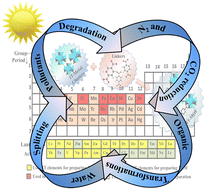Inner transition metal-modulated metal organic frameworks (IT-MOFs) and their derived nanomaterials: a strategic approach towards stupendous photocatalysis
Abstract
Photocatalysis, as an amenable and effective process, can be adopted for pollution remediation and to alleviate the ongoing energy crisis. In this case, recently, metal organic frameworks (MOFs) have attracted increasing attention in the field of photocatalysis owning to their unique characteristics including large specific surface area, tuneable pore architecture, mouldable framework composition, tuneable band structure, and exceptional photon absorption tendency complimented with superior anti-recombination of excitons. Among the plethora of frameworks, inner transition metal based-MOFs (IT-MOFs) have started to garner significant traction as photocatalysts due to their distinct characteristics compared to conventional transition metal-based frameworks. Typically, IT-MOFs have the tendency to generate high nuclearity clusters and possess abundant Lewis acidic sites, together with mixed valency, which aids in easily converting redox couples, thereby making them a suitable candidate for various photocatalytic reactions. Therefore, in this contribution, we aim to summarise the excellent photocatalytic performance of IT-MOFs and their composites accompanied by a thorough discussion of their topological changes with a variation in the structure of the metal cluster, fabrication routes, morphological features, and physico-chemical properties together with a brief discussion of computational findings. Moreover, we attempt to explore the scientific understanding of the functionalities of IT-MOFs and their composites with detailed mechanistic pathways for in-depth clarity towards photocatalysis. Furthermore, we present a comprehensive analysis of IT-MOFs for various crucial photocatalytic applications such as H2/O2 evolution, organic pollutant degradation, organic transformation, and N2 and CO2 reduction. In addition, we discuss the measures employed to enhance their performance with some future directions to address the challenges with IT-MOF-based nanomaterials.

- This article is part of the themed collection: Recent Review Articles


 Please wait while we load your content...
Please wait while we load your content...